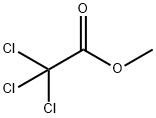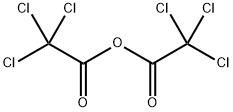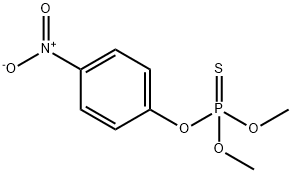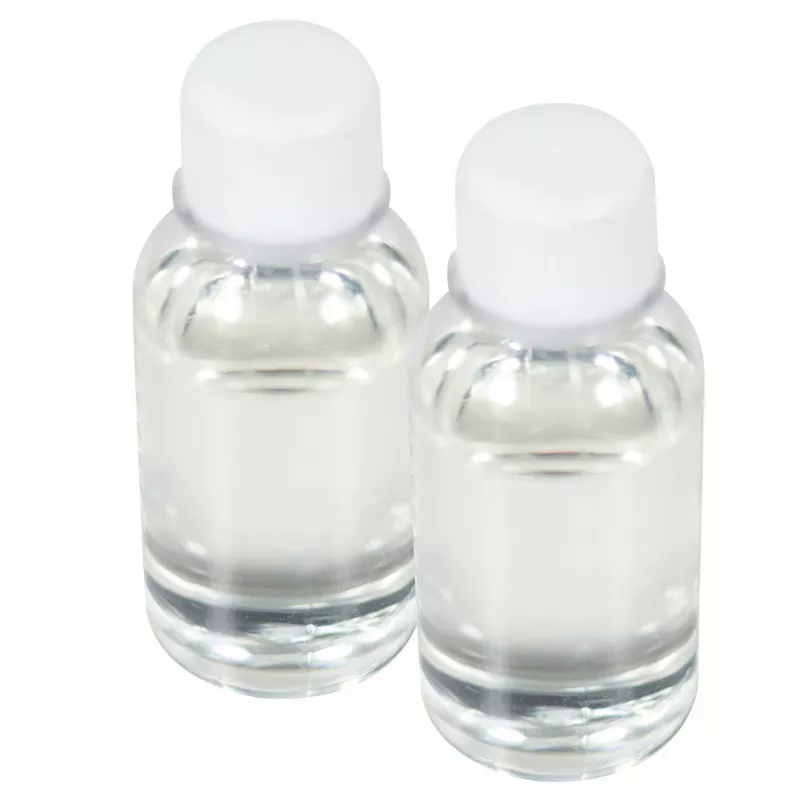Methyl trichloroacetate
- CAS NO.:598-99-2
- Empirical Formula: C3H3Cl3O2
- Molecular Weight: 177.41
- MDL number: MFCD00000794
- EINECS: 209-960-7
- SAFETY DATA SHEET (SDS)
- Update Date: 2025-01-27 09:38:02

What is Methyl trichloroacetate?
Chemical properties
Colorless clear liquid
The Uses of Methyl trichloroacetate
Methyl trichloroacetate was used for negative staining of protein that allowed unmodified proteins to be recovered for biological studies or transblot for amino acid sequence.
What are the applications of Application
Methyl trichloroacetate is a precursor of dichlorocarbene.
Reactions
methyl trichloroacetate reacts with sodium methoxide then the formed product is carbine.
Synthesis Reference(s)
Tetrahedron Letters, 20, p. 3643, 1979 DOI: 10.1016/S0040-4039(01)95485-1
General Description
Methyl trichloroacetate appears as a colorless liquid. Insoluble in water and denser than water. Contact may slightly irritate skin, eyes and mucous membranes. May be toxic by ingestion. Used to make other chemicals.
Air & Water Reactions
Insoluble in water.
Reactivity Profile
A halogenated ester. Esters react with acids to liberate heat along with alcohols and acids. Strong oxidizing acids may cause a vigorous reaction that is sufficiently exothermic to ignite the reaction products. Heat is also generated by the interaction of esters with caustic solutions. Flammable hydrogen is generated by mixing esters with alkali metals and hydrides. A mixture of the ester and trimethylamine reacted violently. Polymerization of a reactive dehydrochlorination of the ester was viewed as the most likely product, along with generous amounts of heat.
Health Hazard
TOXIC; inhalation, ingestion or contact (skin, eyes) with vapors, dusts or substance may cause severe injury, burns or death. Contact with molten substance may cause severe burns to skin and eyes. Reaction with water or moist air will release toxic, corrosive or flammable gases. Reaction with water may generate much heat that will increase the concentration of fumes in the air. Fire will produce irritating, corrosive and/or toxic gases. Runoff from fire control or dilution water may be corrosive and/or toxic and cause pollution.
Fire Hazard
Combustible material: may burn but does not ignite readily. Substance will react with water (some violently) releasing flammable, toxic or corrosive gases and runoff. When heated, vapors may form explosive mixtures with air: indoors, outdoors and sewers explosion hazards. Most vapors are heavier than air. They will spread along ground and collect in low or confined areas (sewers, basements, tanks). Vapors may travel to source of ignition and flash back. Contact with metals may evolve flammable hydrogen gas. Containers may explode when heated or if contaminated with water.
Properties of Methyl trichloroacetate
| Melting point: | -18°C |
| Boiling point: | 152-153 °C (lit.) |
| Density | 1.488 g/mL at 25 °C (lit.) |
| refractive index | n |
| Flash point: | 163 °F |
| storage temp. | room temp |
| solubility | 1050mg/l |
| form | clear liquid |
| color | Colorless to Almost colorless |
| Water Solubility | Insoluble in water |
| BRN | 1756075 |
| Dielectric constant | 8.7899999999999991 |
| CAS DataBase Reference | 598-99-2(CAS DataBase Reference) |
| NIST Chemistry Reference | Acetic acid, trichloro-, methyl ester(598-99-2) |
| EPA Substance Registry System | Acetic acid, 2,2,2-trichloro-, methyl ester (598-99-2) |
Safety information for Methyl trichloroacetate
| Signal word | Warning |
| Pictogram(s) |
 Skull and Crossbones Acute Toxicity GHS06  Exclamation Mark Irritant GHS07 |
| GHS Hazard Statements |
H227:Flammable liquids H302:Acute toxicity,oral H312:Acute toxicity,dermal H315:Skin corrosion/irritation H319:Serious eye damage/eye irritation H331:Acute toxicity,inhalation H335:Specific target organ toxicity, single exposure;Respiratory tract irritation |
| Precautionary Statement Codes |
P261:Avoid breathing dust/fume/gas/mist/vapours/spray. P280:Wear protective gloves/protective clothing/eye protection/face protection. P305+P351+P338:IF IN EYES: Rinse cautiously with water for several minutes. Remove contact lenses, if present and easy to do. Continuerinsing. P405:Store locked up. |
Computed Descriptors for Methyl trichloroacetate
New Products
Indole Methyl Resin tert-butyl 9-methoxy-3-azaspiro[5.5]undecane-3-carboxylate Boc-His(Boc)-OH 2-CTC Resin 4-Chloro-7-tosy1-7Hpyrrolo[2,3-d]pyrimidine 5,7-Dibromo-1H-indole 2,5-dichloro-N-hydroxy-4,6-dimethylpyridine-3-carboximidamide 2,2-Dimethoxy-7-azaspiro[3.5]nonane hydrochloride 4-chloromethyl-5-methyl-1,3-dioxol-2-one (DMDO-Cl) R-2-BENZYLOXY PROPIONIC ACID 1,1’-CARBONYLDIIMIDAZOLE 1,1’-CARBONYLDI (1,2-4 TRIAZOLE) N-METHYL INDAZOLE-3-CARBOXYLIC ACID 4-((2-hydroxyethyl)thio)benzoic acid 1-(TERT-BUTOXYCARBONYL)-2-PYRROLIDINONE Methyl 6-methylnicotinate 3-Pyridineacrylic acid tert-Butyl carbazate TETRAHYDRO-2H-PYRAN-3-OL 2-((4-morpholinophenylamino) (methylthio) methylene) malononitrile 3-(4-morpholinophenylamino)-5-amino-1H-pyrazole-4-carbonitrile 2,4-dihydroxybenzaldehyde 1,3-Diethyl-1,3-Diphenylurea Methyl 2-methylquinoline-6-carboxylateRelated products of tetrahydrofuran








You may like
-
 598-99-2 98%View Details
598-99-2 98%View Details
598-99-2 -
 Methyl trichloroacetate 99%View Details
Methyl trichloroacetate 99%View Details
598-99-2 -
 Methyl Trichloroacetate CAS 598-99-2View Details
Methyl Trichloroacetate CAS 598-99-2View Details
598-99-2 -
 Methyl trichloroacetate, 96% CAS 598-99-2View Details
Methyl trichloroacetate, 96% CAS 598-99-2View Details
598-99-2 -
 Pyridine 99.5% HPLC /UV SpectroscopyView Details
Pyridine 99.5% HPLC /UV SpectroscopyView Details
110-86-1 -
 Dibutyl PhthalateView Details
Dibutyl PhthalateView Details
84-74-2 -
 Imidazole Spot supply, competitive priceView Details
Imidazole Spot supply, competitive priceView Details
288-32-4 -
 Thiourea 99% ARView Details
Thiourea 99% ARView Details
62-56-6
